 |
 |
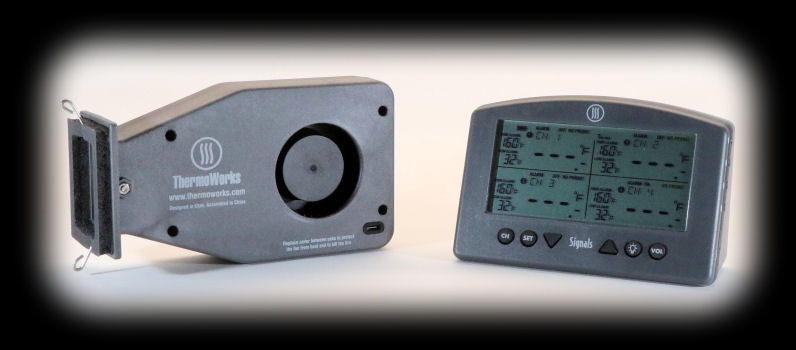
The display is a 1.88" x 3.97" LCD display with backlight. The backlight is not adjustable. Here is what the display looks like with the backlight on:
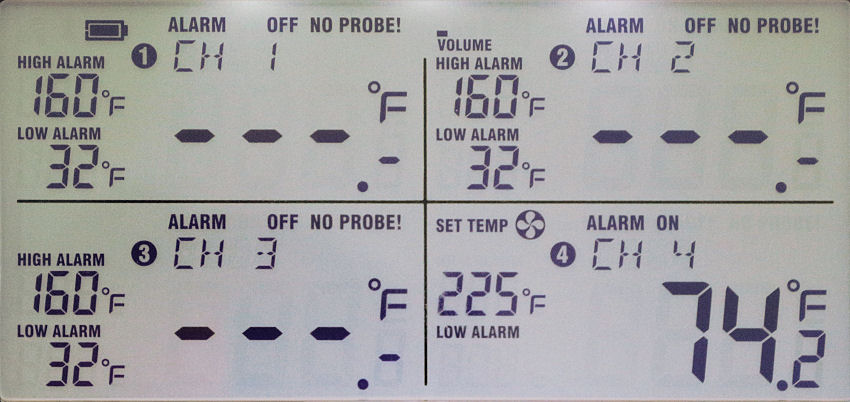 Since the Signals unit is intended to be a BBQ Alarm Thermometer, the display is pretty much filled up with items for that purpose. Everything displayed is pretty self-explanatory except for the changes that were made to channel 4 to accomodate the Billows blower. Normally, channel 4 looks just like the other three channels. However, when you plug the Billows fan adapter into the Signals unit, plug power and the Billows blower into the adapter and then finally once you plug a temperature probe into channel 4, the display for channel 4 looks like this:
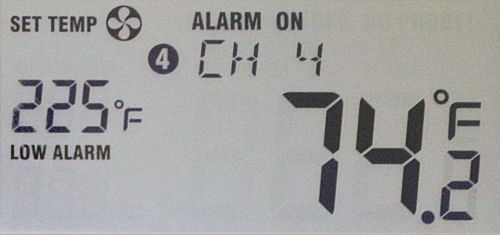 The "SET TEMP" and image of fan blades in the upper left corner appear when you have the Billows blower all set up to go. Also the values for the high and low alarms disappear and are replaced by the target temperature for your cooker. The words "HIGH ALARM" and "LOW ALARM" only display when the pit temperature exceeds ±25°F of the target pit temperature. In this picture, the LOW ALARM condition has been triggered since the actual temperature measured by probe 4 is outside of that range. All the connections are on the right end of the Signals unit. As you can see, there is a connection for a USB-C cable as well as four temperature probes.
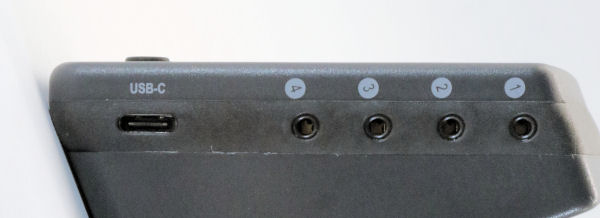 The Signals unit is powered by 12V DC. It comes with a power adapter that can be used with 100-240V AC. Also provided is a 77" USB-C cable. The Signals unit has an internal battery that can be recharged with the supplied 12V power adapter and cable. However, be aware that to use the Billows blower, you must use the 12V power adapter to power the Signals unit. It will not run off the internal battery.
At first we didn't think we were going to be able to come up with a battery option for the Billows/Signals unit.
Thermoworks had no recommendation, and in fact, seemed to say it wasn't possible.
But we did find a couple of ways to do this. First, you need to go to Amazon and purchase a couple of cables.
We bought the
SinLoon USB 3.1Type-C Male to DC5.5 X 2.5mm Male Female Power Plug Extension Charge Cable for Tablet OmniCharge (USB-C to DC M F 1Pair)
If you have a battery for jump starting your car and the cigarette lighter cable, you can plug that cable into the female to USB-C cable and then plug the USB-C plug into the Billows fan adapter. Alternatively, if you happen to have one of the "12V Power Adapter For DeWalt 20V Battery Pack" from Auber instruments, you can plug the male cable into the Auber battery adapter and the USB-C plug into the Billows fan adapter. Using one of these two cables, you should be able to connect a 12 volt power source to the Billows fan adapter. The Signals BBQ Alarm Thermometer comes with one pit temperature probe and three food temperature probes.
The probes are made from stainless steel and contain thermistors. Each probe has a 49" braided stainless steel cable. The cable can handle up to 700°F (370°C) while the probes can handle -58 to 572°F (-50 to 300°C). The transition between the cable and the probe can handle up to 644°F (340°C). A grate clip is provided with the pit probe which you can use to clip the probe to your food grid. The probes and the wires should be shielded from direct radiation from a hot fire. Do not let it come into direct contact with flames. If you need to shield the wire, you can place a layer of aluminum foil beneath it. Also, having the pit probe itself exposed to direct radiant heat can cause it to register a temperature which is higher than the air temperature in the cooker, and thus fool the controller into cutting back on the fire. Thermoworks advertises the following accuracy for these probes when used with the Signals device:
We measured the temperature of boiling water using the SMOBOT controller. Using our boiling point calculator to determine the boiling point of water in our locaton (211.5°F), we then measured the temperature of boiling water with each of the probes:
As you can see, the food probes were all within a tenth or two between them, while the pit probe was off between 0.7°F and 1.5°F from the food probes. Frankly, this really isn't a concern, since that is more than enough accuracy to control the temperature of a cooker. And compared to the 50° swing that is typical of most kitchen ovens, 1.5° is a tiny blip. How tiny? Well here is how well our $2200 Bosch oven holds 300°F:
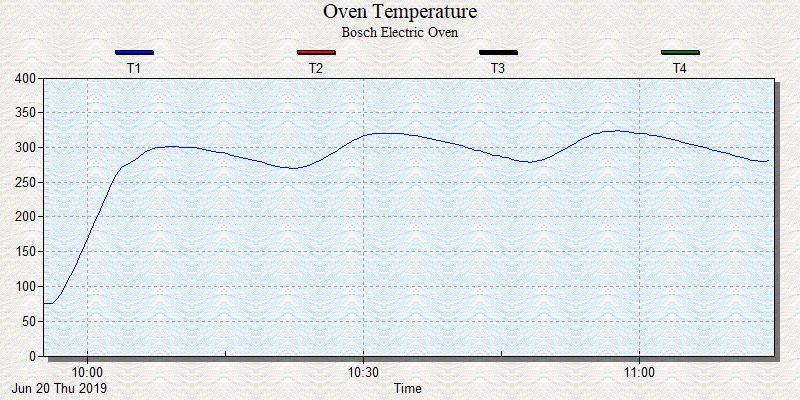 That's a 43°F swing on the last oscillation. Again, a 1.5°F error on your pit temp is irrelevant. There is a calibration function in the Signals App, but be aware that you are not calibrating the probes, you are calibrating the channels that the probes plug into. For example, if the probe plugged into Channel 4 reads 5 degrees low, you can tell the Signals app to add 5 degrees to channel 4. However, if you plug that same probe into channel 3, it will then show 5 degrees low again. And if you plug an accurate probe into channel 4, it will read 5 degrees too high. So if you are going to use the calibration function, you must be sure to always plug each probe into the same channel every time you use the device. The colored silicone rings provided for the probes should help you keep track of the probes. You can also configure the Thermoworks App to show the color associated with each channel. Also note that you cannot use the calibration function on channel 4 while the Billows blower is attached and running. |
You can support this website by shopping at The Naked Whiz Website Store and Amazon.com
|